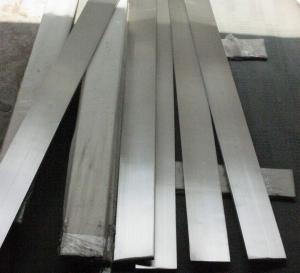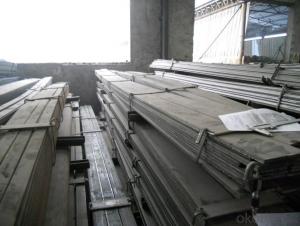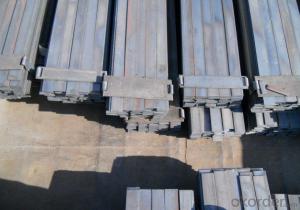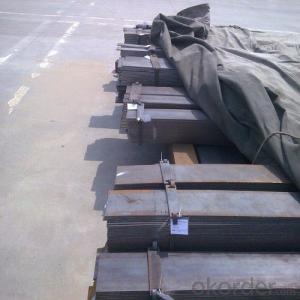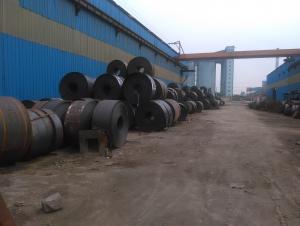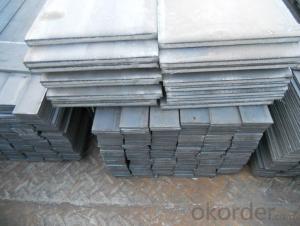Frime Low Carbon Q195 Flat Bars
- Loading Port:
- China Main Port
- Payment Terms:
- TT or LC
- Min Order Qty:
- 100 m.t.
- Supply Capability:
- 10000 m.t./month
OKorder Service Pledge
OKorder Financial Service
You Might Also Like
OKorder is offering Frime Low Carbon Q195 Flat Bars at great prices with worldwide shipping. Our supplier is a world-class manufacturer of steel, with our products utilized the world over. OKorder annually supplies products to African, South American and Asian markets. We provide quotations within 24 hours of receiving an inquiry and guarantee competitive prices.
Product Applications:
Frime Low Carbon Q195 Flat Bars are ideal for structural applications and are widely used in the construction of buildings and bridges, and the manufacturing, petrochemical, and transportation industries.
Product Advantages:
OKorder's Frime Low Carbon Q195 Flat Bars are durable, strong, and wide variety of sizes.
Main Product Features:
· Premium quality
· Prompt delivery & seaworthy packing (30 days after receiving deposit)
· Can be recycled and reused
· Mill test certification
· Professional Service
· Competitive pricing
Product Specifications:
Grade: A36, SS400, Q235, Q195
Standard: ASTM, JIS, GB
Thickness:1.5mm-20mm
Width: 10mm-250mm
Packing: it is nude packed in bundles by steel wire rod
Bundle weight: not more than 3.5MT for bulk vessel; less than 3 MT for container load
Marks:
Color marking: There will be color marking on both end of the bundle for the cargo delivered by bulk vessel. That makes it easily to distinguish at the destination port.
Tag mark: there will be tag mark tied up on the bundles. The information usually including supplier logo and name, product name, made inChina, shipping marks and other information request by the customer.
FAQ:
Q1: Why buy Materials & Equipment from OKorder.com?
A1: All products offered byOKorder.com are carefully selected from China's most reliable manufacturing enterprises. Through its ISO certifications, OKorder.com adheres to the highest standards and a commitment to supply chain safety and customer satisfaction.
Q2: How do we guarantee the quality of our products?
A2: We have established an advanced quality management system which conducts strict quality tests at every step, from raw materials to the final product. At the same time, we provide extensive follow-up service assurances as required.
Q3: How soon can we receive the product after purchase?
A3: Within three days of placing an order, we will arrange production. The normal sizes with the normal grade can be produced within one month. The specific shipping date is dependent upon international and government factors, the delivery to international main port about 45-60days.
Images:
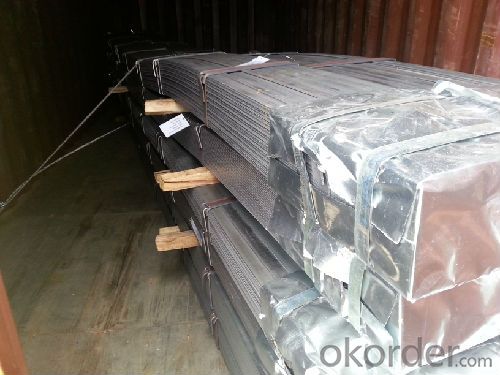
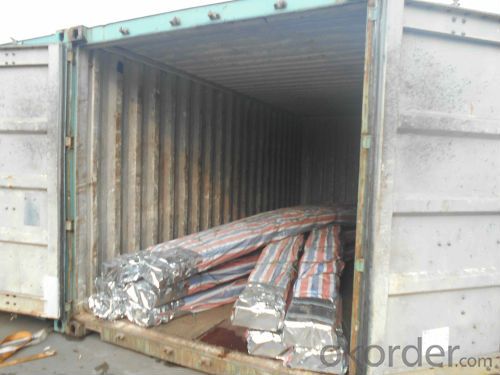
- Q:Can steel flat bars be used for window frames?
- Certainly, window frames can indeed utilize steel flat bars. Steel flat bars possess exceptional strength and durability characteristics, rendering them appropriate for a multitude of structural uses, including window frames. They serve as a steadfast and sturdy framework for securely holding window panes in position. Furthermore, steel flat bars can be effortlessly fabricated and welded, enabling the creation of personalized window frame designs. Their resistance to corrosion further guarantees enduring performance and minimal upkeep demands. All in all, steel flat bars present a dependable and resilient choice for constructing window frames.
- Q:What is flat steel for?
- Hot rolled flat steel is a general purpose rectangular cross section strip. The specifications are expressed in millimeters of thickness * width, flat steel can be finished steel, used for components, ladders, bridges and fences, etc.. Flat steel can also be used to weld rigid steel and billets and slabs of laminated sheets. (material: Q215, Q235), the implementation standard: GB704 - 1988 instead of GB704 - 83, this standard applies to the thickness of 3~60mm, width of 10~200mm, cross section of rectangular hot rolled flat steel for general use. Delivery status: flat steel delivered by straight line. Measurement: flat length and length of flat steel, according to the theoretical weight of delivery.
- Q:Can steel flat bars be used in the manufacturing of machinery?
- Yes, steel flat bars can be used in the manufacturing of machinery. Steel flat bars are commonly used in the construction of machinery components due to their strength, durability, and versatility. They can be shaped, cut, and welded to create various machine parts such as brackets, supports, frames, and structural elements. Additionally, steel flat bars offer good resistance to impact, wear, and corrosion, making them suitable for industrial applications in the manufacturing sector.
- Q:Do lightning protection, lead out of the galvanized round steel, flat steel needs to be inspected?
- The corrosion resistance of cold galvanizing is not as good as that of hot-dip galvanizing. It is used as lightning protection and grounding material. It is corroded quickly, and the grounding resistance is raised rapidly. It exceeds the required resistance.
- Q:Can steel flat bars be used for support brackets or frames?
- Steel flat bars have the capability to serve as support brackets or frames. Renowned for their exceptional strength and durability, they are exceptionally well-suited for offering structural support. In a plethora of applications, be it constructing buildings, manufacturing furniture, or even in the automotive or aerospace sectors, steel flat bars can be employed to fabricate brackets or frames. Their remarkable load-bearing capacity and resistance to bending render them dependable and robust choices for support brackets or frames. Furthermore, they possess versatility and can be effortlessly welded, drilled, or machined to meet precise design specifications.
- Q:What is the maximum thickness of a steel flat bar?
- The maximum thickness of a steel flat bar depends on various factors such as the manufacturing process, the desired application, and the specific type of steel being used. Generally, steel flat bars can range in thickness from a few millimeters to several inches. However, it is important to consult with manufacturers, engineers, or industry standards to determine the maximum thickness for a specific steel flat bar as it can vary depending on the intended use and structural requirements.
- Q:How do you prevent twisting of steel flat bars during welding?
- To prevent twisting of steel flat bars during welding, there are several measures you can take: 1. Proper preparation: Ensure that the flat bars are clean and free of any contaminants, such as oil, grease, or rust. Use a wire brush or grinder to remove any surface impurities. 2. Proper clamping: Securely clamp the flat bars in place before welding. Use sturdy clamps or magnetic welding fixtures to hold the bars firmly in position, preventing any movement or twisting during the welding process. 3. Tack welding: Prior to performing the full weld, use tack welds to temporarily hold the flat bars together. This will help maintain their alignment and prevent twisting while the final weld is being applied. 4. Weld sequence: Adopt a strategic weld sequence that minimizes heat distortion and potential twisting. Avoid welding a continuous bead along the entire length of the flat bars, as this can generate excessive heat and cause distortion. Instead, alternate between different sections or weld in short intervals, allowing each area to cool before proceeding. 5. Minimize heat input: Control the heat input during welding by using the appropriate welding technique and adjusting the welding parameters. High heat levels can cause the steel to expand and contract, leading to twisting. Employing techniques such as pulse welding or reducing the amperage can help control heat input and minimize the risk of twisting. 6. Preheating and post-weld heat treatment: For thicker or more susceptible steel flat bars, preheating the material before welding can help reduce the risk of twisting. Additionally, performing post-weld heat treatment can relieve residual stresses and prevent distortion. 7. Slow cooling: Allow the welded flat bars to cool slowly and naturally after welding. Rapid cooling, such as through water quenching, can induce additional stresses and contribute to twisting. Avoid abrupt temperature changes and provide adequate time for the welded bars to cool down gradually. By implementing these preventive measures, you can significantly reduce the risk of twisting in steel flat bars during welding, ensuring a successful and distortion-free weld.
- Q:Can steel flat bars be used for support beams or columns?
- Steel flat bars can serve as support beams or columns in construction due to their strength and durability. Their ability to provide structural support and stability makes them commonly used in the industry. Nonetheless, it is crucial to assess the project's specific requirements and load-bearing capabilities before utilizing steel flat bars for such purposes. Seeking advice from a structural engineer or construction professional is advised to guarantee the suitability of the steel flat bars for the intended use and compliance with safety standards.
- Q:Can steel flat bars be used for staircases?
- Yes, steel flat bars can be used for staircases. They are often used as stringers or supports for the steps and provide stability and durability to the staircase structure.
- Q:What are the common welding methods used for steel flat bars?
- The common welding methods used for steel flat bars are MIG (Metal Inert Gas) welding, TIG (Tungsten Inert Gas) welding, and stick welding (Shielded Metal Arc Welding).
1. Manufacturer Overview |
|
|---|---|
| Location | |
| Year Established | |
| Annual Output Value | |
| Main Markets | |
| Company Certifications | |
2. Manufacturer Certificates |
|
|---|---|
| a) Certification Name | |
| Range | |
| Reference | |
| Validity Period | |
3. Manufacturer Capability |
|
|---|---|
| a)Trade Capacity | |
| Nearest Port | |
| Export Percentage | |
| No.of Employees in Trade Department | |
| Language Spoken: | |
| b)Factory Information | |
| Factory Size: | |
| No. of Production Lines | |
| Contract Manufacturing | |
| Product Price Range | |
Send your message to us
Frime Low Carbon Q195 Flat Bars
- Loading Port:
- China Main Port
- Payment Terms:
- TT or LC
- Min Order Qty:
- 100 m.t.
- Supply Capability:
- 10000 m.t./month
OKorder Service Pledge
OKorder Financial Service
Similar products
New products
Hot products
Hot Searches
Related keywords


